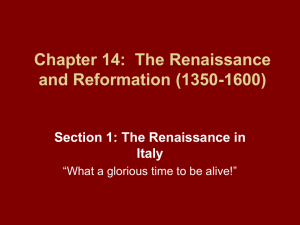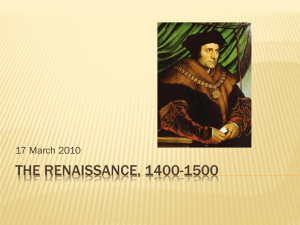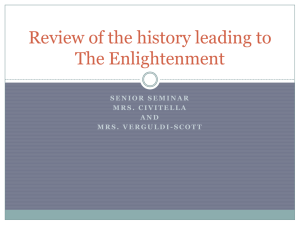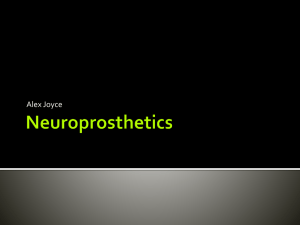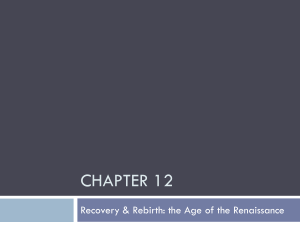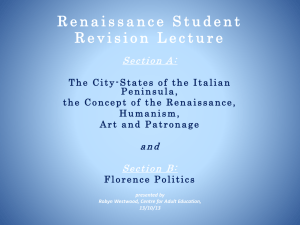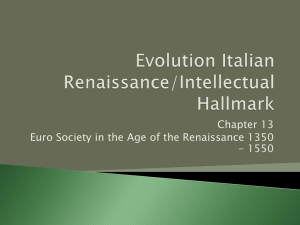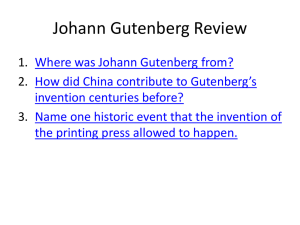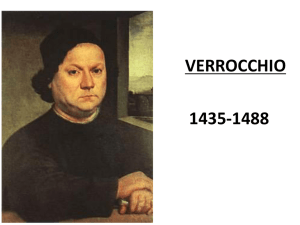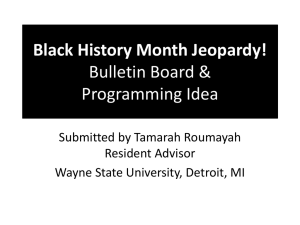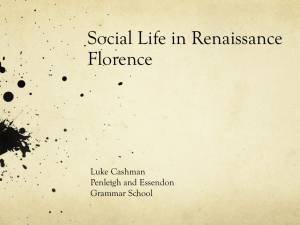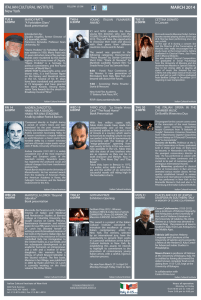Period 4 Italian Renaissance
advertisement
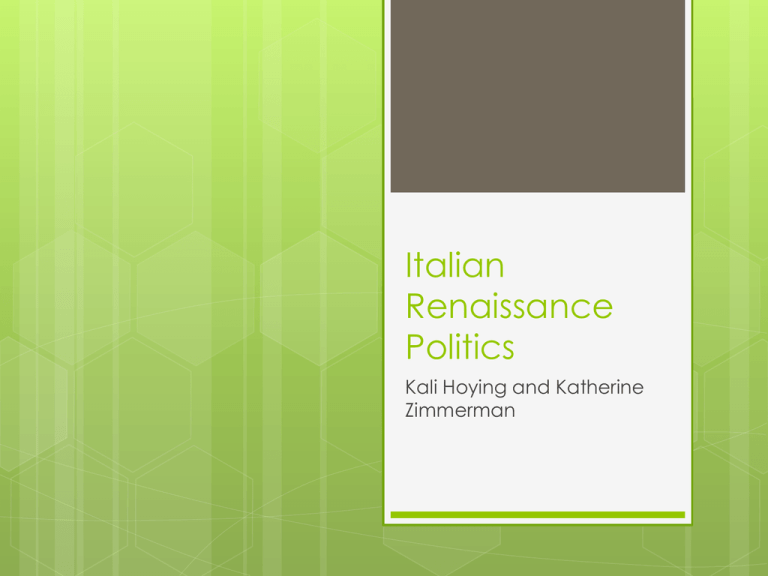
Italian Renaissance Politics Kali Hoying and Katherine Zimmerman Background Begin trading with Europe through the Mediterranean Develops a merchant class City-states gain power Five main city-states Naples & Sicily Milan Venice Papal States Florence Avignon Papacy Popes move to France City-State Information Modern diplomatic system and balance-of-power Ambassadors and alliances Peace of Lodi Armies composed mostly of mercenaries Condottieri = mercenary captains Tendency towards despotism One-man rule Often hereditary City-State Information Princedoms: ruled by an individual with support of his family Milan Monarchies: larger, stronger, and more permanent princedoms Naples and Papal States (though could be considered a theocracy) Republics: run by oligarchies, or balanced councils of the people Venice and Florence Map of Italian City-States Humanism in Politics Removed religion from politics Promoted that the government be run by science Machiavelli “The ends justify the means” Naples & Sicily “Kingdom of the Two Sicilies” Only city-state in Italy with a king Maintained feudalism for a time Popes interfered with their affairs Vassal state of the papacy Involvement of the house of Aragon placed Sicily and Naples under separate rule Continued conflicts to attempt reunification Alfonso of Aragon united them Also attempted to end status as a vassal state Alfonso divided Naples and Sicily again upon his death Major cause of French invasions into Italy Milan Visconti family led Milan Gian Galeazzo Best chance for unification Daughter marries the brother of French king Francesco Sforza becomes ruler Not related to Visconti’s by blood Assisted by Florence in the takeover Peace of Lodi Ludovico the Moor uses young duke as puppet Fails when duke marries the princess of the ruling house of Naples Ends alliance between Florence, Naples, and Milan Convinces French to make claim to throne of Naples Venice Retains republican form of government Merchant aristocracy Council of Ten Designed to expel and extinguish all conspiracies Maintained independence until Napoleon Enemies with Milan Sided with Florence, who later turned and sided with Milan Venice Held a large amount of territory and flourished Currency was recognized throughout the world Ruled Eastern trade Government was stable Begin to decline Conflict with Ottoman Turks Portuguese take over spice trade French, Dutch, and English enter Eastern trade Outbreak of the plague Timber supplies are exhausted Papal States Popes ruled the Papal States Tried to balance headed a city-state and the church Secularized the papacy In political unrest until Great Schism was resolved Popes returned to Rome and left France Popes became increasingly nepotistic and secular Tried to increase state power and interfered in the diplomacy of other Italian city-states Alexander VI and Cesare Borgia Alexander VI restored order to Rome His son Cesare uses papacy resources to create his own territory Cesare tries to manipulate the election of his father’s successor Papal States Julius II Adds Cesare’s territories into the Papal States to increase temporal power Known as “warrior” pope Leo X Medici Extremely lavish and distrusted Did not concern himself with religious matters Clement VII Medici Sides with France over Spain Rome is sacked by the Spanish Ends popes’ interests in diplomacy Florence Papacy aligns itself with Florence Secures bankers the business of the papacy and merchants special privileges Allowed them to take over the government Opposed the Visconti family in Milan Sided with Venetians against them Changed their opinion with Sforza was elected Unofficially ruled by the Medici family Bankers and one of the ruling houses Cosimo de’Medici begins this rule Maintains appearance of a republic Helped Sforza take over Milan to neutralize threat Created a hierarchical rule Florence Lorenzo the Magnificent Grandson of Cosimo Pope excommunicates him and joins Naples in declaring war on Florence Lorenzo goes to Naples without consultation and worked out a peace settlement with the king of Naples Maintains alliance with Naples and Milan, prevents foreign intervention, and stays in good terms with the French Creates a Council of Seventy to run the government and a committee of seventeen to elect the priors Banking business and trade suffer Lorenzo used public funds for private purposes Not allowed since he was a private citizen Italian Decline Fall of the Medici family Savonarola Niccolò Machiavelli The Prince Italian Wars cause Italy to lose its independence Ruled by Spain for almost two centuries Niccolò Machiavelli (1469-1527) Worked for various governments in Florence No political opinion Distrusted and disliked First political scientist Viewed politics in a strictly scientific manner without involving ethics Assisted in the decline of Italian city-states and the end of the Italian Renaissance (involuntarily) The Prince Francesco Guicciardini (1483-1540) Worked for the government in Papal States Medici’s (papacy) senior administrator Sought reformation of republic Political Scientist Discourse composed in Logrogno, Ricordi Stressed that historical situations were unique Considerations on Machiavelli’s Discourses Works not published during his lifetime Girolamo Savonarola (1452-1498) Gains fame in Florence through his preaching “Wrath of God” Criticizes rulers, papacy, and humanists Becomes dictator of Florence and establishes a theocracy Ends the rule of the Medici Develops enemies in the Medici family and the papacy Alliance with France Becomes their puppet Leads to Italian decline Arrested, tortured, and burned at the stake Sources GRENDLER, PAUL F.. "Renaissance." Europe, 1450 to 1789: Encyclopedia of the Early Modern World. 2004.Encyclopedia.com. 1 Sep. 2012 <http://www.encyclopedia.com>. Machiavelli, Niccolò. The Prince. Florence: 1513. Web. <http://www.fordham.edu/halsall/basis/machiavelli-prince.asp>. MCCUAIG, WILLIAM. "Guicciardini, Francesco (1483–1540)." Europe, 1450 to 1789: Encyclopedia of the Early Modern World. 2004. Encyclopedia.com. 1 Sep. 2012 <http://www.encyclopedia.com>. Nelson, Lynn H.. "CHAPTER 3 THE ITALIAN CITY-STATES OF THE RENAISSANCE." Carrie - A Full-Text Electronic Library. N.p., 30 Apr 2012. Web. 1 Sep 2012. <http://vlib.iue.it/carrie/texts/carrie_books/gilbert/03.html>. Nelson, Lynn H.. "CHAPTER 4 THE INVASIONS OF ITALY 1494-1527 MACHIAVELLI AND GUICCIARDINI." Carrie - A Full-Text Electronic Library. N.p., 30 Apr 2012. Web. 1 Sep 2012. <http://http://vlib.iue.it/carrie/texts/carrie_books/gilbert/04.html>. Watson-Novacek, Deborah. "Condottiere - Renaissance Mercenary Captains." BellaOnline The Voice of Women. Minerva WebWorks LLC, 2012. Web. 31 Aug 2012. <http://www.bellaonline.com/articles/art63087.asp>. "Girolamo Savonarola." Encyclopedia of World Biography. 2004. Encyclopedia.com. 1 Sep. 2012<http://www.encyclopedia.com>. "Italian Politics." . N.p., n.d. Web. 1 Sep 2012. <http://wwwstudent.unl.edu/cis/hist100w05/online_course/unit3/lsn09-tp02.html>. “Italian Renaissance Art: Political Background: Machiavelli and Medici." Italian Renaissance Art: Political Background: Machiavelli and Medici. N.p., n.d. Web. 29 Aug. 2012. <http://faculty.uml.edu/Culturalstudies/Italian_Renaissance/6.htm>. "RENAISSANCE: HISTORICAL INFORMATION: The Renaissance." The Miniatures Pages. N.p., 24 May 1996. Web. 31 Aug 2012. <http://theminiaturespage.com/ref/history/reninfo.html>. "Social and Economic Changes During the Renaissance."All-About_Renaissance_Faires.com. N.p., n.d. Web. 1 Sep 2012. <http://www.all-about-renaissancefaires.com/renaissance_info/economic_social_and_religious_change_in_the_renaissance.htm>. The Historical, Political and Diplomatic Writings of Niccolò Machiavelli, trans. C. E. Detmold, 4 vol, Boston 1882. Extract from `Discourses' (I, 55). Web. <http://www.fordham.edu/halsall/source/machiavelli-disc155.asp>. The Renaissance: Italian Literature By: Natalie Marshall important literary Renaissance Humanism movement in the Italian Most Renaissance An intellectual movement Derived from the study of classical literary works of the Greeks and Romans People who studied humanism were called “humanists” Renaissance Humanism Studied the liberal arts which they derived from the writings of the ancient Greeks and Romans The subjects that were studied are called “humanities” Worth and dignity of a person was emphasized Shift from theology and logic to human studies Some form of syncretism was present- would mix present society ideals with the works and thoughts of the ancient Roman and Greek world Italian Humanism Connected to Florentine spirit “Civic Humanism” and pride Rejected family Promoted intellectuals Looked to the Roman Cicero as a model Believed it was the responsibility of an intellectual to be productive for their state One can only mature if they participate in the activities and life of the state “Civic Italian Humanism Humanism” Reflected the values and ethics of urban society during the Italian Renaissance Studies of humanities should be put into practice Humanists often served as chancellors, councilors, and advisors to the state Very interested in classical Greek civilization Humanist Interest in the Greeks Humanists researched and read the works of Plato Humanists also followed Greek poets, dramatists, historians, and orators Read the works of Thucydides, Euripides, and Sophocles Humanists pursued the works of the classical Greeks while people of the middle ages ignored the Greeks Humanism on Education Profound impact on education Believed humans could be greatly benefitted by education Books were written on education Schools were established Most famous being one founded by Vittorino de Feltre at Mantua in 1423 Educational system was based off of the ideas of Cicero and Quintilian Liberal studies “Father Francesco Petrarch of Humanism” Brought popularity to renaissance humanism His father wanted him to become a lawyer, but he pursued a career in literature instead Not modest at all 1st person to describe the Middle Ages as a period of darkness Searched monastic libraries in Europe for Latin manuscripts Placed Francesco Petrarch great emphasis on classical Latin Emphasis on Latin caused humanists to use Cicero and Virgil as models “Christ is my God; Cicero is the prince of the language” – Petrarch The Ascent of Mount Ventoux Written by Petrarch It is an allegory of the struggle of his soul to reach a higher spiritual state “nothing is admirable besides the soul; compared to its greatness nothing is great” Look inward and forget worldly objects “And men go to admire the high mountains, the vast floods of the sea, the huge streams of the rivers, the circumference of the ocean, and the revolution of the stars- and desert themselves.” Leonardo Bruni He was a chancellor of Florence He wrote the New Cicero A biography on Cicero Talked about the mixture of political action and literary creation in the life of Cicero To mature intellectually and morally one most participate in the state Gained a through knowledge of the Greeks- one of the first Italian humanist to do this Also wrote the History of the Florentine People Lorenzo Valla 1407-1457 Raised in Rome Knew both Latin and Greek Eventually became a papal secretary Used knowledge of the classical languages to criticize ideas, theories, beliefs, and practices of modern times He was highly controversial He said that the Donation of Constantine (a document that justified the papacy's claim to temporal rule) as forgery, or fake. • Lorenzo Valla Wrote, The Elegances of the Latin Language • • • Wanted to restore Latin to how it was prior to medieval times Advocated proper use of classical Latin Only acceptable form of Latin was that between the last century of the Roman Republic and the 1st century of the empire Renaissance Hermecticism Cosimo de’ Medici asked Marsilio Ficino to translate a Greek work, Corpus Hermeticum, into Latin The writings spoke of how everything was of divine nature- heavenly bodies and earthly objects “God as a whole is in all things” – Giordano Bruno Wrote one of the most Giovanni Pico della Mirandola famous pieces of writings to come out of the Renaissance He wrote, The Oration on the Dignity of Man He researched the works of many philosophers to come up with the story Very interested in Hermetic philosophy The Oration of the Dignity of Man Written as a preface to Mirandola’s 900 theses In it Mirandola wrote that humans have unlimited potential “To him it is granted to have whatever he chooses, to be whatever he wills.” –Mirandola “You, constrained by no limits, in accordance with your own free will, in whose hand We have placed you, shall ordain for yourself the limits of your nature.” -Mirandola Humanism’s Impact on History Humanists strongly impacted the recording of history Influenced by classical Roman and Greek historians, and not by those of the Middle Ages Began to think in passages of time- chronologized the past into the ancient world, the dark ages, and then their own age Started to secularize history Focused more on political forces or individuals Medieval historical literature emphasized God intervention in human affairs while the Humanists emphasized human motives Francesco Guiccidardini Historian during the Renaissance To Renaissance scholars he was the greatest historian Wrote the History of Italy and the History of Florence Recordings of history were meant to teach lessons, but lessons were not always in plain view He was experienced in government and diplomatic affairs which enabled him to analyze political situations Used personal examples and documentary sources for his works Bibliography Petrarch. "The Ascent of Mount Ventoux." Francesco Petrarch. Peter Sadlon, 1999. Web. 04 Sept. 2012. <http://petrarch.petersadlon.com/read_letters.html?s=pet17.html>. "The Renaissance Humanists." The Renaissance Humanists. N.p., n.d. Web. 04 Sept. 2012. <http://www.roebuckclasses.com/ideas/humanist.htm>. Sadlon, Peter. "Francesco Petrarch - Father of Humanism." Francesco Petrarch Father of Humanism. N.p., 1999. Web. 04 Sept. 2012. <http://petrarch.petersadlon.com/petrarch.html>. Nauta, Lodi. "Lorenzo Valla." (Stanford Encyclopedia of Philosophy). Stanford University, 19 May 2009. Web. 04 Sept. 2012. <http://plato.stanford.edu/entries/lorenzo-valla/>. Nelson, Lynn H. "ITALIAN HUMANISM." ITALIAN HUMANISM. European University Institute, May 1993. Web. 04 Sept. 2012. <http://vlib.iue.it/carrie/texts/carrie_books/gilbert/05.html>. Mirandola, Pico Della. "Oration on the Dignity of Man." Preface. Western Civilization. Fifth ed. Belmont: Thomson Wadsworth, 2003. 317. Print. Women Painting The Italian Renaissance Painting Italian Renaissance Began in mid 14th century Due to the growth of city-states. Various City-States Florence Center of the Renaissance Rome Venice Longest lasting Naples King Sicily Middle Ages Artists were members of religious houses No sculptures Idolatry One Dimensional General Information Art Realism Linear Perspective Depth Frescoes Landscapes Mythology The Madonna ¾ portraits Why & How? The revival of classical, Romanesque architecture inspired classicism in painting. Vitruvius Math=Art! New artistic techniques/ideas Open Mindedness Humanism Inspiration and $$$ The Medici Bank Cosimo Vitruvius 1st Century Writer “On Architecture” The Bellini Family Venice The Catholic Church Various Rich People A few people to know… Leonardo THE MAN Da Vinci Michelangelo and Raphael The OTHER Men Donatello Titian Giotto Masaccio Bruneleschi Leonardo da Vinci (1452-1519) Emphasis on humans, nature, and landscapes. Focused on the math involved in painting/drawing. Inventor Mona Lisa, The Last Supper, The Vitruvian Man Michelangelo (1475-1564) Focus on architecture Designed the Medici Chapel Large role in the “High Renaissance” Also a poet “The flesh now earth, and here my bones, Bereft of handsome eyes, and jaunty air, Still loyal are to him I joyed in bed, Whom I embrace, in whom my soul now lives.” David, The Creation of Adam, Sistine Chapel Ceiling Raphael (1483-1520) Simplicity and human grandeur. Known outside of Rome for his printmaking School of Athens Sources Medici. "Medici Archive: Document Details." Medici Archive: Document Details. Medici Family, 2005. Web. 04 Sept. 2012. <http://documents.medici.org/document_details.cfm?entryid =722>. Medici. "Medici Archive: Document Details." Medici Archive: Document Details. Medici Family, 2005. Web. 04 Sept. 2012. <http://documents.medici.org/document_details.cfm?entryid =10687>. Ferguson, John. "Middle Ages Art." Middle Ages Art. Middle Ages, 2009. Web. 04 Sept. 2012. <http://www.middleages.org.uk/middle-ages-art.htm>. Italian Renaissance Architecture How it relates to the time period: Renaissance architecture is the architecture of the period between the early 15th and early 17th centuries in different regions of Europe demonstrating a conscious revival and development of certain elements of ancient Greek and Roman thought and material culture. Stylistically, Renaissance architecture followed Gothic architecture and was succeeded by Baroque architecture. Developed first in Florence, with Filippo Brunelleschi as one of its innovators, the Renaissance style quickly spread to other Italian cities Italian Architecture: Style of architecture, reflecting the rebirth of Classical culture, that originated in Florence in the early 15th century and spread throughout Europe, replacing the medieval Gothic style. Middle Ages Architecture: Medieval Architecture featured different styles which were called Romanesque, the French Style, Perpendicular style both more commonly as Gothic architecture. How it relates to the region: In Italy people are coming out of the Dark Ages &they want a whole new way of doing “life” Italians were moving away from the Gothic style or architecture that they have known for so long Italy displays “Renaissance Architecture” very well throughout the region Evidence: Sistine Chapel: Outside & Inside People: Filippo Brunelleschi Trained as a goldsmith in his native city of Florence, Brunelleschi soon turned his interests to architecture, traveling to Rome to study ancient buildings. Among his greatest accomplishments is the engineering of the dome of Florence Cathedral (Santa Maria del Fiore, also known as the Duomo). He was also the first since antiquity to use the classical orders Doric, Ionic, and Corinthian in a consistent and appropriate manner. Leon Battista Alberti Worked as an architect from the 1450s onward, principally in Florence, Rimini, and Mantua. As a trained humanist and true Renaissance man, Alberti was as accomplished as an architect as he was a humanist, musician, and art theorist. Alberti‘s treatises on architecture De re Aedificatoria Andrea Palladio Andrea Palladio (1508–1580) was the chief architect of the Venetian Republic, writing an influential treatise, I quattro libri dell'architettura. Due to the new demand for villas in the sixteenth century, Palladio specialized in domestic architecture, although he also designed two beautiful and impressive churches in Venice, San Giorgio Maggiore (1565) and Il Redentore (1576). Palladio's villas are often centrally planned, drawing on Roman models of country villas. Sources: Primary: "The Civilization of the Renaissance In Italy." About.com Medieval History. N.p., n.d. Web. 02 Sept. 2012. <http://historymedren.about.com/od/burckhardt/ a/cri_main.htm>. "Top Sources." Eastbury Manor House. N.p., n.d. Web. 02 Sept. 2012. <http://www.britishhistory.ac.uk/report.aspx?compid=117579>. Secondary: "Architecture of Italy - Great Buildings Online." Architecture of Italy - Great Buildings Online. N.p., n.d. Web. 03 Sept. 2012. <http://www.greatbuildings.com/places/italy.html >.
